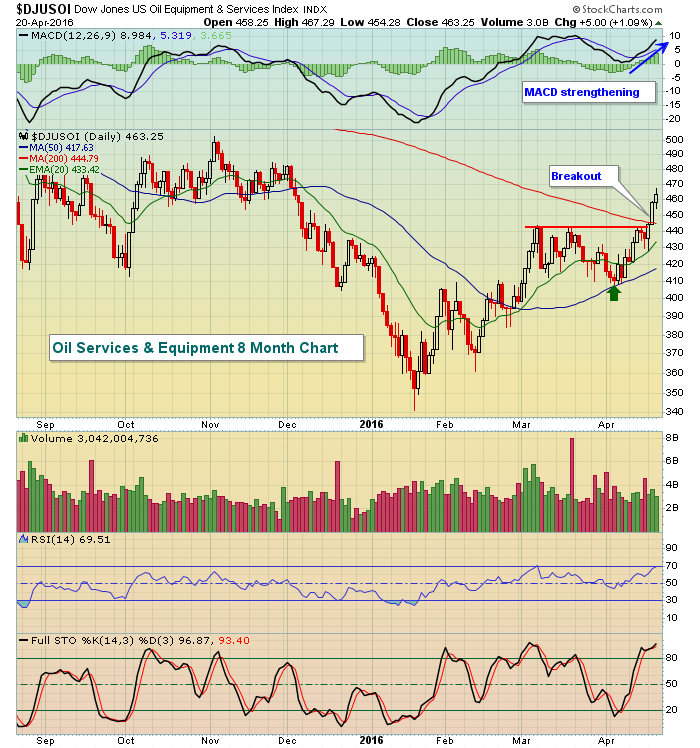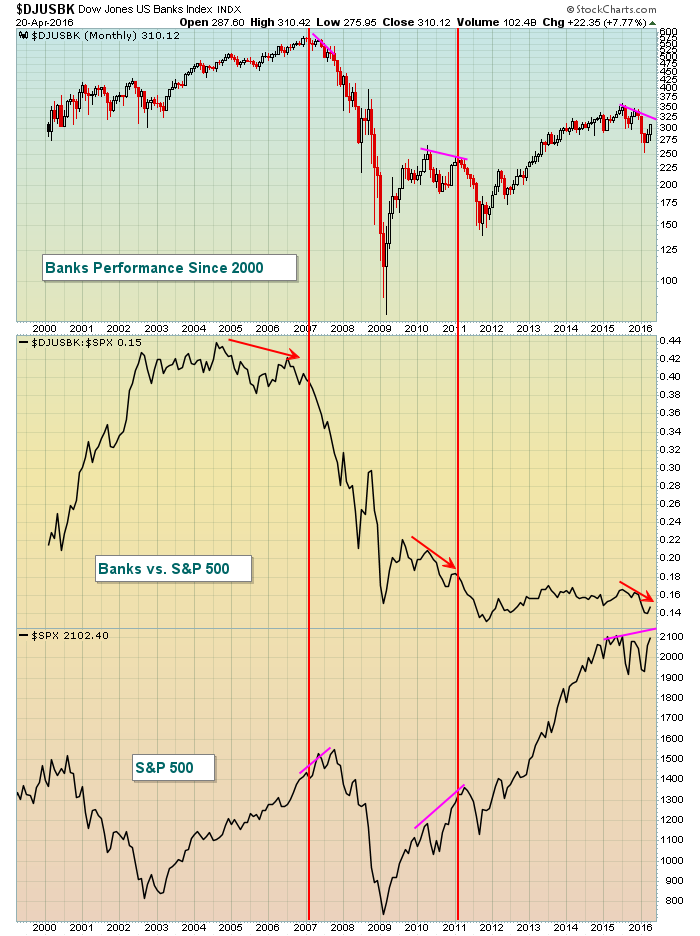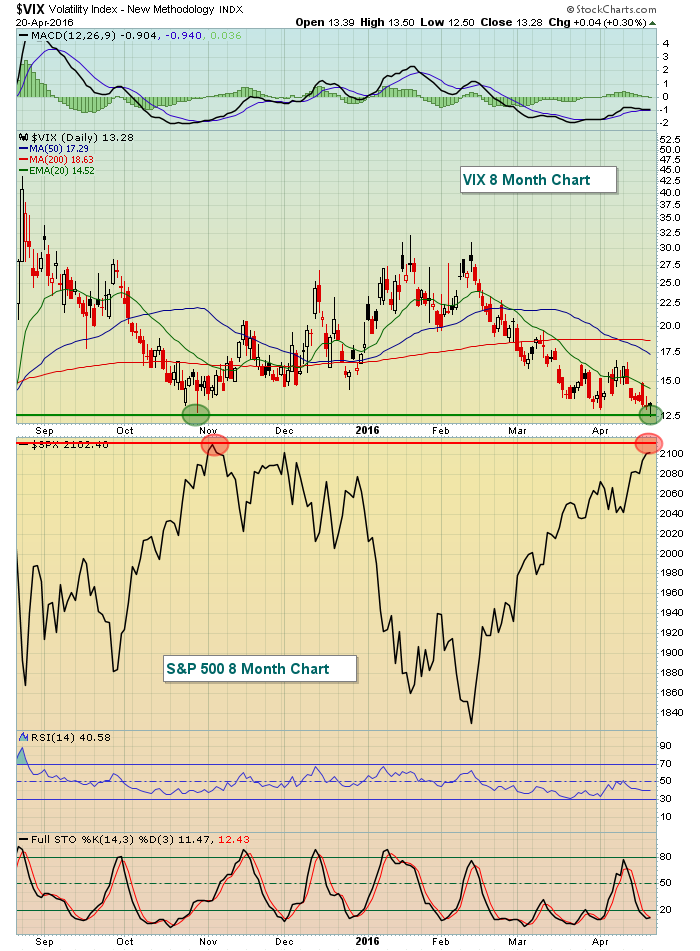Market Recap for Wednesday, April 20, 2016
Energy (XLE) once again found itself on top of the relative leaderboard in terms of sector performance. The XLE gained .90% on Wednesday. Oil equipment and services ($DJUSOI) gained over 1% and broke to fresh highs. Here's an update on that industry group:
 The recent breakout is notable because it's part of the best performing sector of 2016 (energy). The rising 20 day EMA should provide excellent support on any subsequent pullback.
The recent breakout is notable because it's part of the best performing sector of 2016 (energy). The rising 20 day EMA should provide excellent support on any subsequent pullback.
Banks ($DJUSBK) also performed extremely well on Wednesday and are highlighted throughout today's article.
Struggling to keep pace on Wednesday were the defensive consumer staples (XLP) and utilities (XLU). Utilities were particularly weak, dropping 2.50% with rising treasury yields the likely culprit. Those rising yields make dividends on utility stocks less attractive.
Pre-Market Action
Traders are attempting to decipher a ton of news this morning. First, there's a large number of companies reporting their latest quarterly results and most earnings seem to be fairly strong with only a few notable exceptions (Travelers - TRV- came up 10% short of EPS consensus estimates and is down nearly 3%).
Then there's economic news where initial jobless claims were reported at 247,000, the lowest level since 1973. But the Philadelphia Fed Survey was reported in negative territory and that was unexpected.
Finally, ECB President Mario Draghi is speaking at a news conference and ANY discussion of economic stimulus has typically sent global markets higher, trumping all other news.
On Wednesday, the 10 year treasury yield ($TNX) surged higher, finishing back above its 20 day EMA and 50 day SMA for the first time in nearly a month. The mass exodus out of treasuries is a positive sign for equities should it continue. The TNX is up another 2 basis points this morning to 1.88%. The 1.90%-2.00% is the intermediate-term zone to watch. Rising yields are generally regarded as bullish for many key areas of the financial sector, such as banks and life insurance companies. Perhaps the breakout in banks is stemming from the anticipation of a further rise in yields. Again, the 1.90%-2.00% likely holds the key here.
In Asia, the Tokyo Nikkei ($NIKK) was up 2.70% and closed at its highest level since February 2nd. The Hong Kong Hang Seng ($HSI) rose 1.82%, closing at its highest level in 2016. The China Shanghai Composite ($SSEC) failed to follow its Asian counterparts, falling fractionally overnight.
In Europe, major markets are down fractionally as traders there watch the Draghi news conference closely.
Current Outlook
The outlook always improves when banks ($DJUSBK) show relative strength. Banks are truly the engine of the stock market because businesses rely on credit availability. We're a debt driven economic society. If you look back at history, the S&P 500 performs best when banks are leading on a relative basis. They need to at least be going along for the ride. The stock market's stumbles many times can be directly linked to an underperforming banking group. Check out the following chart:
 If you study the S&P 500 uptrends, you'll see that banks typically move higher as well with the relative ratio ($DJUSBK:$SPX) at least remaining flat (which means that banks are performing equal to the S&P 500). That's generally a key ingredient to a bull market. Note that the pink lines show that the S&P 500 is moving higher while banks are moving lower and that obviously results in a declining relative ratio. That scenario has preceded significant drops in the S&P 500. One problem I've had with the sustainability of the bull market has been the underperformance of banks over the past 9-12 months. If the S&P 500 breaks out, the banks have some catchig up to do. The good news is that the banks have cleared key short- to intermediate-term resistance. Take a look:
If you study the S&P 500 uptrends, you'll see that banks typically move higher as well with the relative ratio ($DJUSBK:$SPX) at least remaining flat (which means that banks are performing equal to the S&P 500). That's generally a key ingredient to a bull market. Note that the pink lines show that the S&P 500 is moving higher while banks are moving lower and that obviously results in a declining relative ratio. That scenario has preceded significant drops in the S&P 500. One problem I've had with the sustainability of the bull market has been the underperformance of banks over the past 9-12 months. If the S&P 500 breaks out, the banks have some catchig up to do. The good news is that the banks have cleared key short- to intermediate-term resistance. Take a look:
 Support in the 290-300 area (green shaded area) had been quite strong prior to the early 2016 bank meltdown. Moving back through the 290-300 resistance area (red shaded area) was critical to sustaining any attempt at an S&P 500 breakout above 2131. So chalk one up to the bulls. I wouldn't say the bulls are out of the woods with respect to bank performance, but the banks have definitely taken a step in the right direction.
Support in the 290-300 area (green shaded area) had been quite strong prior to the early 2016 bank meltdown. Moving back through the 290-300 resistance area (red shaded area) was critical to sustaining any attempt at an S&P 500 breakout above 2131. So chalk one up to the bulls. I wouldn't say the bulls are out of the woods with respect to bank performance, but the banks have definitely taken a step in the right direction.
Sector/Industry Watch
Volatility ($VIX) has completely evaporated in the U.S. stock market and perhaps poses the biggest problem currently for the bears. During the bear markets of 2000-2002 and 2007-2009, the VIX never fell below 16-17. It closed on Wednesday at 13.28 after printing an intraday low of 12.50. The behavior in the VIX most definitely supports the correction theory, not a bear market. A high level of volatility suggests fear, a necessary bear market ingredient. During bear markets, good news is routinely ignored while selling accelerates on bad news. The opposite is true currently. The banks (chart reflected above) are a perfect example of bull market behavior where several banks have reported disappointing quarterly results only to watch the bank index break out above key resistance levels in an effort to resume its earlier uptrend.
Below is a look at the VIX currently:
 The last time the VIX neared 12.50, we saw the S&P 500 top just a few trading days later. Over the past year, the 12.50 level has marked high complacency and stock market tops. That's the bears' hope for now - that complacency has reached a level where the bulls will have difficulty pushing the market any higher. Of course, we know that the VIX can move to much lower levels and the bull market continues, we'll likely see the VIX eventually reach 10.
The last time the VIX neared 12.50, we saw the S&P 500 top just a few trading days later. Over the past year, the 12.50 level has marked high complacency and stock market tops. That's the bears' hope for now - that complacency has reached a level where the bulls will have difficulty pushing the market any higher. Of course, we know that the VIX can move to much lower levels and the bull market continues, we'll likely see the VIX eventually reach 10.
Historical Tendencies
The strongest part of the second half of April has passed (April 16 through April 18), but the remainder of the month isn't bad. Since 1950 on the S&P 500, we've seen the April 21 (today) through April 30 period produce annualized returns of 8.37%, close to the 9% gains the S&P 500 has enjoyed throughout the year. So as we head into the final 10 days of April, let's call it a historical draw between the bulls and bears.
Key Earnings Reports
(actual vs. estimate):
BBT: .69 vs .64
BIIB: 4.79 vs 4.48
BK: .74 vs .68
BX: .31 vs .40
DHI: .52 vs .47
GM: 1.26 vs 1.01
LUV: .88 vs .84
TRV: 2.33 vs 2.58
UA: .04 vs .02
VZ: 1.06 vs 1.06
(reports after close, estimate provided):
GOOGL: 6.36
MSFT: .63
NSC: .97
SBUX: .39
SLB: .41
V: .66
Key Economic Reports
Initial jobless claims released at 8:30am EST: 247,000 (actual) vs. 265,000 (estimate)
April Philadelphia Fed Survey released at 8:30am EST: -1.6 (actual) vs. 9.0 (estimate)
February FHFA house price index to be released at 9:00am EST: +0.4% (estimate)
March leading indicators to be released at 10:00am EST: +0.5% (estimate)
Happy trading!
Tom
